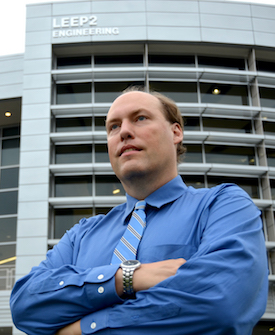Researchers at KU, WVU to strengthen water-stewardship practices for U.S. energy production
LAWRENCE — Every year in the U.S., a whopping 20 billion barrels of water are generated as a byproduct of domestic oil and gas recovery, according to the U.S. Department of Energy.
Safe and environmentally responsible management of this “produced water” is important to energy companies, farmers, ecosystems and everyday people whose drinking water comes from associated aquifers.
 Now, a joint research effort founded by the University of Kansas and West Virginia University — funded by a new $4 million grant from the National Science Foundation — aims to develop cutting-edge strategies for better management, treatment, protection and recovery of produced water. The scientists behind the work hope to establish a permanent center focused on research-proven best practices for handling produced water nationwide.
Now, a joint research effort founded by the University of Kansas and West Virginia University — funded by a new $4 million grant from the National Science Foundation — aims to develop cutting-edge strategies for better management, treatment, protection and recovery of produced water. The scientists behind the work hope to establish a permanent center focused on research-proven best practices for handling produced water nationwide.
“Obviously, we need energy,” said Edward Peltier, KU associate professor of civil, environmental and architectural engineering, who is the primary investigator of the new project. “We use energy resources every day, and we’ll continue to use them. That means the better job we do producing energy in an efficient, clean manner — and not affecting other resources like water quality — the better off we are.”
Paul Ziemkiewicz, co-PI of the new grant and director of the West Virginia Water Research Institute at WVU, pointed out that until now there has been no nationally coordinated research effort to address issues tied to produced water. “NSF’s support will create a national center for technology development as well as training and outreach to recruit a new generation of specialists to address this challenge,” he said.
All oil and gas production, whether by conventional or hydraulic fracturing methods, generates produced water. Its characteristics vary among the nation’s petroleum basins.
“It’s a combination of returned water injected into the ground as part of oil and gas recovery, as well as formation water, trapped inside the rock along with the petroleum — how much water comes out depends on the local geology. Kansas wells produce more water than oil,” Peltier said.
Ziemkiewicz added that Appalachian shale gas wells are net water consumers.
“So far, new well completions have absorbed most of our produced water, but as new completions decline, we need to find new ways to manage this water,” he said.
Across the country, this water has high salt content and other contaminants.
As a result, the researchers said there are issues with reusing water directly or discharging it on the surface. Currently, the leading form of disposal of produced water is reinjection into the subsurface. The practice has gained notoriety in some regions because of its association with earthquakes. Indeed, Kansas now puts regulatory curbs on deep-well re-injection of produced water.
The research under the new NSF grant will develop practices to improve the safety of deep-well injection and develop economical methods for treating produced water so that it can be reused.
“We want to come up with management and treatment techniques so we can reuse this water,” Peltier said. “It needs to be treated before it can be reused. This project is focused on ways to treat the water, to manage the production process so we have less wastewater to deal with and looking at the impact of water in ecosystems when it’s released. How much do we treat it so it doesn’t have harmful effects?”
Differences in the geology of plains Kansas and mountainous West Virginia mean the joint investigation into produced water at KU and WVU will have national application.
“We’ll initially focus on the central plains and Appalachian basins,” Peltier said. “We think there will broader applicability to the work we do that will apply to other petroleum basins.”
Moreover, the research assets of the partner institutions will complement each other. For instance, WVU operates the Marcellus Shale Energy and Environment Laboratory, a long-term field site supported by the DOE National Energy Technology Laboratory. WVU researchers led by Ziemkiewicz are studying water used in hydraulic fracturing through the late stages of the produced water cycle.
Similarly, KU has field resources already established that will sustain the partnership.
“KU has the Tertiary Oil Recovery Program that has worked with oil producers in Kansas developing various recovery strategies and large-scale field tests,” Peltier said. “The goal here is both KU and WVU have overlap in energy and production and water treatment and protection. So we want to establish a long-term relationship, so even at end of this grant we’ll have additional cross-disciplinary and cross-university projects extending beyond the length of the grant.”
Students at both universities will benefit from new programs created by the grant, which the researchers said would help train a new generation of experts in sustainable oil and gas recovery practices.
“We’ll have undergraduate students cross-training each other's universities and departments to strengthen research ties and match students with instructors at both schools, and we’ll have junior faculty going back and forth to establish partners they can work with in the lab, in the field and at the well in West Virginia,” Peltier said.
Researchers at KU involved in the new NSF grant include Stephen Randtke and Belinda Sturm in the Department of Civil, Environmental and Architectural Engineering; Karen Peltier and Jyun-Sung Tsau in the Tertiary Oil Recovery Program, and Reza Barati in the Department of Chemical & Petroleum Engineering. In addition to the Water Research Institute, the WVU team includes Lance Lin, civil and environmental engineering; Harry Finklea, chemistry; Joe Donovan, geology; Todd Petty and Eric Merriam of Wildlife and Fisheries, and Shawn Grushecky of the Energy Land Management Program.